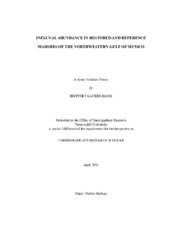| dc.contributor.advisor | Armitage, Anna | |
| dc.creator | Davis, Brittney | |
| dc.date.accessioned | 2015-06-24T18:38:34Z | |
| dc.date.available | 2015-06-24T18:38:34Z | |
| dc.date.created | 2011-05 | |
| dc.date.issued | 2011-05-04 | |
| dc.date.submitted | May 2011 | |
| dc.identifier.uri | https://hdl.handle.net/1969.1/ETD-TAMU-2011-05-9679 | |
| dc.identifier.uri | https://hdl.handle.net/1969.1/154375 | |
| dc.description.abstract | One widely accepted approach to mitigate the loss of natural marsh habitat is to restore marshes in areas that were previously open water. To better understand the infaunal
community within restored marshes, infauna were collected from a restored and reference brackish marsh in East Texas. The restored marsh was constructed using multiple methods to incorporate a variety of different morphologies. A one-way
ANOVA was used to determine if significant differences in species richness and density existed among the habitat types. Sediment characteristics were also measured to address
infaunal-sediment relationships. No significant differences were observed between habitat types for either average infauna abundance (P= 0.654) or species richness (P =
0.748). Additionally, no significant correlations were found for sediment and total infauna abundance. Similar infaunal communities in the reference and restored marsh suggests that the recovery of constructed marshes to reference conditions occurs in less than 4 years. | en |
| dc.format.mimetype | application/pdf | |
| dc.subject | infauna, reference marsh, restored marsh, restoration construction technique, soil organic content | en |
| dc.title | Infaunal abundance in restored and reference marshes of the northwestern Gulf of Mexico | en |
| dc.type | Thesis | en |
| thesis.degree.department | Marine Biology | en |
| thesis.degree.discipline | Marine Biology | en |
| thesis.degree.grantor | Honors and Undergraduate Research | en |
| thesis.degree.name | Bachelor of Science | en |
| dc.type.material | text | en |
| dc.date.updated | 2015-06-24T18:38:34Z | |


